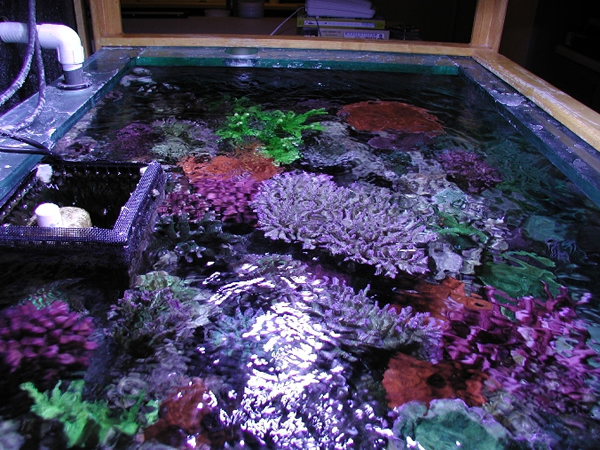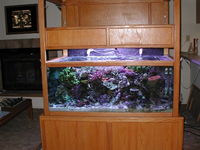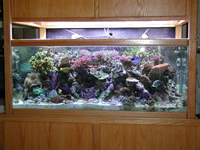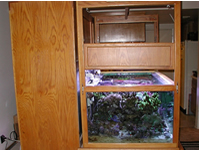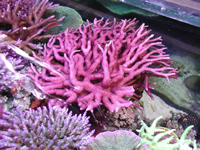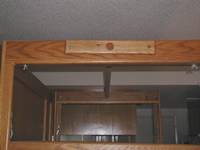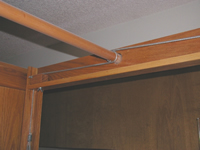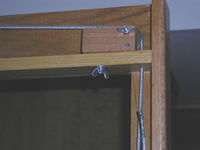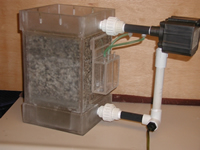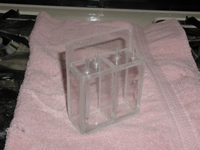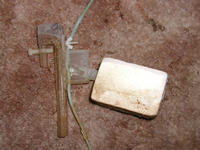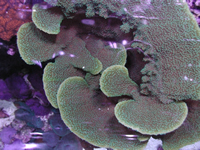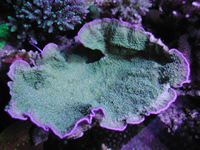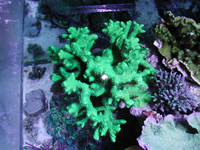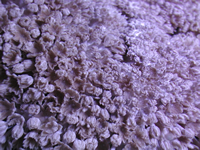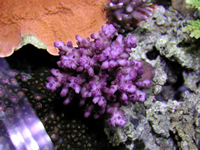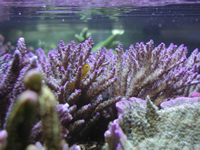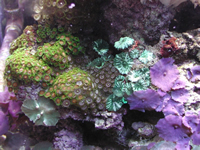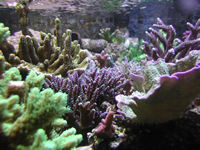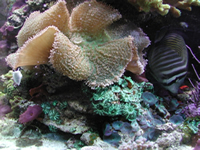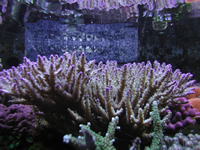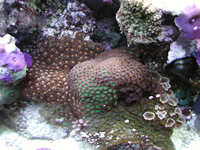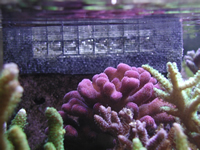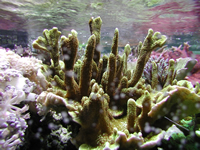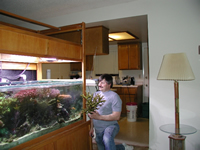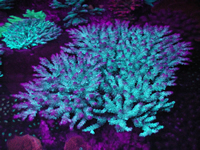
|
|
|
Tracy Gray's (Mutagen)
Reef Tank
First, I would like to say I feel honored to be included in the company of those who have preceded me. This site has featured so many truly magnificent marine aquariums that it's a bit difficult for me to find anything to say or show that adds to the previous featured tanks. But, I'll give it a try... When setting up my 200 gallon reef, I wanted to build a system that was maintenance friendly, especially with regard to working in the aquarium itself. I also wanted to build a system that did not require tedious manual water top-offs or kalkwasser additions and the like. Finally, I had already observed that the kaleidoscope of colors provided by stony corals and clams is best viewed from the top. So with those goals in mind, I built the following tank. Overall DescriptionThe tank is a 200 gallon system with a nominal 60 gallon sump and was set up in May of 2000. Its footprint is 5 feet by 3 feet, and it is 2 feet deep. To facilitate top-down viewing, the tank has an open top with no center brace and the top is about 45 inches off the floor. There is external circulation to the sump that is split into a 30 gallon refugium, with the remaining 30 gallon volume being used to house the return pump, skimmer feed pump, and chiller pump. This section also includes the float valve that provides make-up water. All the ancillary equipment except the calcium reactor is located behind the tank since the stand is too low to house it. The area under the stand is simply used for storage. The system includes both soft and stony corals, but it is primarily stocked with Acropora and Montipora. Almost every coral in the tank was grown from a fragment, with only a few being transferred from a previous 100 gallon system. I would describe the fish load as moderate to slightly heavy. As is common and appropriate, the higher light corals are placed on the "prime real estate" nearer the surface of the water, while the lower light corals are placed near the bottom and along the outside perimeter of the tank.
The lighting is a mix of four 175 watt Ushio 10,000K and two 400 watt 20,000K Radium metal halide (MH) bulbs. There is no fluorescent supplementation since I feel the 20,000K Radium bulbs provide enough blue color by themselves. Since the tank has a somewhat unusual footprint, I tried to orient the lights to provide good coverage for the entire area. To do this, I placed the (4) 10,000K bulbs at each corner of the overhead canopy and placed the (2) 20,000K bulbs evenly in the center of the canopy. There are MANY different combinations of light available, but to my eyes, this combination has been the best. I have been using this combination for the last year and a half and have been very happy with the color and growth rates of my corals. On the subject of lighting and coloration, I can make some observations. Some of the corals with large amounts of the green fluorescing pigments seem to express that color better under the 20,000K lights compared to the 10,000K lights. They appear more fluorescent to the eye, and I believe this may be due to various fluorescent properties of the 20000K bulbs. In contrast, corals with a lot of red pigment such as the pink Stylophora and pink Seriatopora have shown this color better under the 10,000K light. I guess this really just adds one more anecdotal story to lighting controversy, but it is what I have seen, so I thought I'd pass it along.
The light canopy may be of interest to some readers. It is built on a framework that not only supports the canopy, but also provides a wooden border around the edges of the tank. The canopy height can be adjusted by means of a simple winch system made from sliding glass door rollers and a closet hanger pole. All the parts were found at Home Depot. All the lights are on timers. I use the mechanical type timers as opposed to the X10 technology, since I have found the X10 to be insufficiently reliable with my lights. The mechanical timers fit well into the multiple outlet power strips that can also be found at Home Depot.
Filtration Description Filtration is biological and mechanical. A homemade skimmer provides the mechanical filtration. Biological filtration is via a deep sand bed, live rock, and a refugium. About one half of the live rock is "artificial," being made from cement and a calcium carbonate substrate or old reef bed material mined in Utah. In my experience, the completely man-made rock takes at least a year to get a good growth of sponges, worms, coralline algae, amphipods, copepods, forams, feather dusters, etc. Also, only about 25% of the sand was "live" with the remainder added as dry "dead" sand. I do use carbon from time to time. This is mainly aimed at eliminating any chemical competition between the various animals. As is the case with most aquariums, I don't know the degree to which chemical competition is occurring, but at least the water is clear.
Plumbing and Other Devices The external circulation exits the tank through a pretty standard weir overflow. The only difference is that I had the overflow built 4" from the back wall to provide room to hide two MAG 950 pumps for additional circulation. Since the overflow weir is on the back wall, there are four sides for water to spill over instead of the "normal" three. There is an advantage to the additional overflow length: the change in height when flow stops is minimized. The return flow enters from the back of the tank on either side. It is divided by a splitter box located behind and above the tank. This box also houses an area where cryptic organisms tend to dwell. I think the flow through this zone is too high to support the kind of cryptic community I am trying to foster. Food is also added into the splitter box from a "Rondomatic" automatic feeder. I mention this because I have found this feeder to be superior to some other designs. Make up water is added from a reservoir also located above and behind the tank. The make up rate is controlled by a homemade float control valve which I think is actually superior to the commercial units I have seen. All of the make up water is saturated in calcium hydroxide. I use a calcium reactor in addition to topping off with calcium hydroxide. The reactor is also homemade. I wanted it to be easy to duplicate, so I made it only from parts easily found at Home depot or other hardware stores. The result was a rectangular reactor that holds more substrate for its size than comparable round units. Of course, I still had to purchase the CO2 tank and regulator. (DIY'ers should stay tuned though, because I am working on an even simpler design.) The tank also requires a chiller. I use a 1/3 HP chiller, and also use fans over the sump to assist cooling. The tank will typically require 3 gallons per day make up water.
The bubble counter is made to be both a drip counter and bubble counter. LivestockThe tank is what I would call moderately loaded with respect to fish. I have four tangs, and three pygmy angels, a Pseudochromis splendidens, two algae blennies, and a black cap basslet. Other mobile invertebrates include three brittle stars, two sand eating cucumbers, multiple hermit crabs and snails. I have also unintentionally kept some unwanted invertebrates such as a Montipora eating nudibranch and some Acropora eating flatworms. As for the corals, I have multiple unidentified and tentatively identified Acropora and Montipora, Stylophora, Seriatopora, Pocillopora, Turbinaria, Merulina, Echinopora, Hydnophora, and some very recently acquired Porites. I have also tried to line the bottom perimeter of the tank with various Discosoma and zoanthids. The tank no longer houses any Sarcophyton, which for reasons unknown to me, do not do well in this system.
Maintenance I try to exchange about 15 gallons of water per week on a regular basis. I use a SeaChem vitamin and amino acid supplement called Reef Plus. I add it anywhere from daily to twice a week in no particular pattern. Is it really useful? Who knows? As stated earlier, calcium and alkalinity are maintained by use of a calcium reactor and a 24/7drip of calcium hydroxide solution. The fish are fed flake food twice daily by an automatic feeder. The tangs seem to stay fat from this food, and whatever they can find growing on the glass and rocks.
Chemistry I guess this subject should embarrass me since I am a chemical engineer, but I measure almost nothing on a regular basis. When I do measure, I am able to find no nitrate or phosphate with LaMotte test kits. I do check the alkalinity once, or sometimes twice, a month. I try to maintain a value of about 3.5 -4.0 meq/l. When I measure calcium it is always between 450 and 500 ppm.
Concluding Comments Again, I am not sure I can add anything to the body of captive reef keeping knowledge, but I can always add to the body of anecdotal observations. I have had what I would call extremely good growth rates with certain corals in this system. I have removed/harvested around three square feet of plating Montipora corals from this tank over the last two years. In addition, I have taken dozens of Acropora, Seriatopora, and branching Montipora fragments as well. Some of these have been large enough to be characterized as small colonies. On the other hand, I have found the growth rates of certain Acropora and most of the soft corals in the tank to be rather slow compared to other systems I have observed. In particular, the zoanthids have grown slowly, as has the photosynthetic gorgonian. Some Discosoma have grown at what I would call a moderate rate, while the Tonga blue "shrooms" couldn't outrun a glacier. When comparing my tank to other tanks with 6500K bulbs, I have observed that the 6500K bulbs do not seem to provide any higher growth rates than what I am getting with the higher Kelvin bulbs. The coloration is markedly different and some corals do show more intense color with the 6500K bulbs. Obviously, it's difficult to compare one tank to another in order to compare lighting regimens. But if we find a preponderance of people making the same observations, maybe some general rules of thumb can be reached. I believe the relatively slow growth rate of soft corals in my tank is due to it being relatively nutrient poor compared to tanks where soft coral growth rates are high. Most of the "SPS" corals seem to get a higher percentage of their nutrition from photosynthesis compared to the soft corals. Then again, I have intentionally placed them in the most intense light.
The physical set up of the system has, indeed, reduced the amount of work needed to keep the system running well vis a vis the routine maintenance jobs such as adding top off water and alkalinity supplements, etc. However, this has been offset by the work required to keep the corals trimmed back. Another problem has been the slow encroachment of zoanthids over the base of the "SPS" corals. Even though shaded by the corals above them, the zoanthids do eventually make their way up the bases of the hard corals and subsequently kill off the lower tissue of the stony corals. The carpet of zoanthids growing below the "SPS" looks pretty nice, but eventually it creates a fair mount of work in controlling where the different animals grow. If I were to build this tank again, I would build it higher off the floor to make viewing from the side easier. Then, I would build a small bench all the way around the tank where one could sit or stand and easily view from the top. I have been very happy with the canopy and crank mechanism, and very happy with the open top configuration, and highly recommend this layout for reef systems. The one last thing I would like to be able to do is minimize the total electrical power required for the system. If I could, I would do this by using natural light through a light funnel. Since I prefer a bit of a bluer look than sunlight above the surface of the water, I would likely filter out some of the orange and green light and hopefully also remove some of the heat in natural sunlight. Or, better yet, when I build that 30,000 gallon pool outside and turn it into a reef I can... Guess I should wake up now.
I hope this article has been enjoyable and maybe even provided some ideas for other aquarists. If there are questions, I will do my best to answer in the forum for the online magazine.
The last two photos taken under "black light.
|


